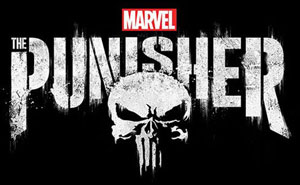After his memorable introduction in “Daredevil” Season 2 (2016) – which could’ve been called “Daredevil and Punisher” – Frank Castle/Punisher (Jon Bernthal) gets the spotlight in his own 13-episode season. The revelation of who killed Frank’s wife and two children at the merry-go-round leads to a conspiracy that goes to the highest levels of the U.S. government and military.
Not faced-paced, but not boring
One approach for showrunner Steve Lightfoot’s “Punisher” Season 1 (2017) might’ve been 13 mini-“John Wick” movies. That would’ve been viscerally satisfying, but I appreciate the meaty roster of characters. The season is not faced-paced, but nor is it boring.
While the violent action is expertly crafted when we do get it, “The Punisher’s” lingering impression is the people. It’d be easy to label Frank a loner, but he does draw friends to his side, notably David Lieberman (Ebon Moss-Bachrach), who is secretly living in the basement of a power plant and in possession of evidence of a videotaped murder by U.S. soldiers. We also see that Frank cares deeply for reporter Karen (Deborah Ann Woll, from “Daredevil”) and David’s wife and two kids, who believe David is dead.

“The Punisher” Season 1 (2017)
Netflix, 13 episodes
Creator: Steve Lightfoot
Stars: Jon Bernthal, Amber Rose Revah, Ben Barnes
Frank is not a man who doesn’t care; he’s a man who cares more than most, and he’s frustrated with the lack of justice coming from the justice system. In a parallel thread, we follow Department of Homeland Security agent Madani (Amber Rose Rivah), who believes justice can happen within the system.
Serving as military foils for Frank are young Lewis Walcott (Daniel Webber) and Frank’s contemporary, Billy Russo (Ben Barnes); Webber and Barnes give two of the season’s best performances outside of the incredible Bernthal. Lewis is the classic soldier who can’t turn off his need to fight, and he becomes a terrorist bomber.
Billy puts himself ahead of justice, getting in deep with corrupt CIA agent Rawlins (“24’s” Paul Schulze, a master at playing bureaucratic sleaze). While Frank and others do a fair amount of hand-wringing about whether Frank is any different from these villains, he obviously has a much sharper sense of right and wrong.
Frank can dish it out
Frank is a master at dishing out extremely graphic violence, though, and that’s what makes a viewer – and the New York City citizens on “The Punisher” — feel subversive if they root for him. Like John Rambo, he is a killing machine built by the military who has no home outside of war (and like, Rambo, Frank intends to only kill the baddest of the bad), but that’s merely the starting point.
Lewis is only comfortable being at war, and Billy is comfortable in the cocoon of the war-making hierarchy. Frank’s inner journey to decide whether war or family life is his “home,” and to then arrive at that home without losing his mind, is at Season 1’s core. Yes, “The Punisher” is a slow-burn drama more so than an orgy of shoot-’em-ups and fisticuffs, but the wealth of character beats about war-ravaged psyches make it enthralling.

Here are my rankings of the 13 episodes:
1. “Cold Steel” (episode 8, written by Felicia D. Henderson)
This is the most fascinatingly unpredictable episode, in a good way. The climactic shootout doesn’t even involve Frank, and we get a creepy closing image of Billy washing blood off a stunned Madani in her bathtub while she’s none the wiser that he killed her DHS partner, Sam (Michael Nathanson). Frank is intriguingly playing substitute family man: David’s wife, Sarah (Jaime Ray Newman), asks Frank to talk to her son Zach (Kobi Frumer), who is turning into a bully.
So we brace ourselves for a classic Bernthal speech scene. In a twist, we learn Zach’s violent behavior is a cry for help, not an indication that he’s a budding psychopath, and before long he and Frank are playing catch. The season’s most intense scene involves no weapons: Sarah kisses Frank, with David watching on a video monitor.
2. “Danger Close” (11, Henderson)
This is straight-up “The Punisher being The Punisher” porn as Frank rigs the power-station basement lair as a death trap and takes out Billy’s soldiers like Rambo in the forest in “First Blood.” Sure, it’s worth a chuckle when Frank announces that his plan is to “kill them all” (it’d be fun to hear a tactical planning session between him and John Wick), and it’s a long-awaited nod to the comics when he spray-paints the skull logo on his body armor. Still, Frank’s tactics are as smart as they are deadly, and it’s fun to see how he takes out his enemies with rigged bombs and stashed guns.
3. “Home” (12, Dario Scardapane)
When Frank gets up from the chair where he’s been tortured and viciously beats Rawlins to death, it’s a rare case where a villain’s demise is commiserate with the evil he has committed. Contrasting and complementing that incredible violence is the episode’s artistry.
It initially struck me as artsy-for-the-sake-of-artsy that Frank’s mind drifts from the torture to happy memories with his late wife, Maria (Kelli Barrett). Then I picked up on how his memories represent heaven and the torture represents Earth – but on another level, the memories represent home and the torture represents the endless overseas war.
4. “Gunner” (5, Michael Jones-Morales)
Watching other people play “007” is boring. But watching Frank pick off Rawlins’ soldiers in autumnal woods — with the killings being viewed by Rawlins on a monitor that shows his men’s first-person perspective (similar to the Indominous rex hunt in “Jurassic World”) – is deliciously satisfying. This is also where David proves his worth to Frank, providing crucial drone reconnaissance.
5. “Memento Mori” (13, Lightfoot)
I usually scoff at suggestions that Frank is no different from villains like Billy and Lewis, but this episode starts with Frank telling Madani he pulled the trigger in the Afghan murder video. Thus we are challenged for feeling complicit with Frank.
Then the hour pulls back and draws a cleaner line: Billy uses two teenage park workers as bait during his final showdown with Frank on the infamous merry-go-round. Still, after this emotionally draining season, we deserve the tidy-yet-honest ending: All the bad guys have been killed or captured, the Liebermans have a happy Thanksgiving, and the government lets Frank go free – but he heads for the veterans’ support group, not for the warm family meal.
6. “Resupply” (4, Scardapane)
While “Punisher” isn’t as “John Wickian” as some “Wick” fans might’ve hoped, those folks are thrown a bone with a thrilling muscle-car chase between Frank and Madani. Before that, Billy gives a rousing speech to his soldier-for-hire recruits at Anvil that I can see appealing to ex-soldiers who don’t want to live in “the gray,” as Lewis puts it.
7. “The Judas Goat” (6, Christine Boylan)
By “Punisher” standards, this is a feel-good episode as Frank and David remember past Thanksgivings with their families and Frank promises Sarah a bright future, even though things look bleak. (It would’ve been easy, and perhaps expected, for “Punisher” to descend further into bleakness, but I love how the season really does end with a Lieberman Thanksgiving).
Through six episodes, I felt there was something slightly off about Billy – thanks to Barnes’ performance as a guy who’s a little too perfect – and it’s confirmed here as we see him conspiring with Rawlins.
8. “Two Dead Men” (2, Lightfoot)
In the showdown between Frank and conspirator Wolf (C. Thomas Howell), it’s cool to see Frank purposely get himself tied up in order to be in position to outsmart his adversary. And a major thematic conflict is highlighted: Yes, Frank is a victim (as we know from “Daredevil”), but he’s also a villain (as per the Afghanistan murder video).
9. “3AM” (1, Lightfoot)
Out of the gates, it’s clear we’re back to a “Daredevil” level of quality after a few less-competent Netflix MCU series, even though Lightfoot and his writing team don’t have “Daredevil” in their background. It starts with wish fulfillment and fan service as Frank kills unambiguous bad guys, cleaning up loose ends from the “Daredevil” Season 2 turf war, but it also hints at Frank’s hazy but painful Afghanistan memories, which will form the centerpiece of the narrative.
10. “Front Toward Enemy” (9, Angela LaManna)
While Frank isn’t as much of a loner as one might assume, “The Punisher” is undeniably an insular show. This hour is notable for opening things up, starting with a gun-control debate on local radio (not “Trish Talk,” for some reason).
Karen’s view is nicely nuanced, as she doesn’t support bombings in the name of gun rights, but she knows first-hand the value of having a gun for self-defense. Also, a fresher debate is posed about the morality of killing methods, with Frank noting that he kills his targets in person, rather than using bombs in cowardly fashion.
11. “Crosshairs” (7, Bruce Marshall Romans)
Here we get a showcase for Walcott. Lewis hates that Second Amendment rights are being eroded, but how does one find the target in that fight? It’s ephemeral, and out of frustration and perhaps a shortage of self-worth, he wavers between wanting to kill himself or kill others.
When we see Lewis’ dad desperate to help his son, without knowing how, it gives us sympathy for the relatives of real-world bombers; we see how easy it is to “not see it coming.” Speaking of frustrating: Bulletproof glass prevents the story from ending right here, as Frank delivers an otherwise perfect kill shot to Rawlins (But hey, we knew it wasn’t a seven-episode season).
12. “Virtue for the Vicious” (10, Ken Kristensen)
I have mixed feelings on this one. It is a strong, if inevitably tragic, conclusion for the arc of Lewis, who sees everyone as either part of the problem or part of the solution. It opens with a nice metaphor: Lewis tries to let two pet birds go free, but they are happier in their cage – something he didn’t consider when he started his crusade for a populace that doesn’t crave freedom like he does. But it gets a little old for both the viewer and Karen as she constantly has to tell investigators that Frank is not responsible for the bombing at a pro-gun-control senator’s hotel room.
13. “Kandahar” (3, Lightfoot)
The title refers to the location of the off-the-books illegal mission where an Afghan citizen is murdered; Frank and David seek to kill and/or expose the perpetrators throughout the season. But the memorable part of this hour, unfortunately, is that Frank tortures (that’s perhaps too strong of a word, based on what we see later in the season) David until he’s sure he can trust him. It struck me early on that David would become Frank’s ally, so like C-3PO in “The Empire Strikes Back,” I wanted to yell “Trust him! Trust him!”

